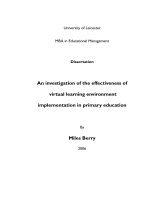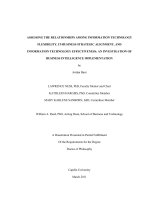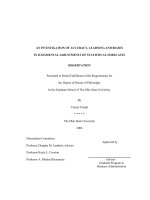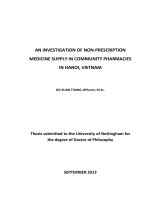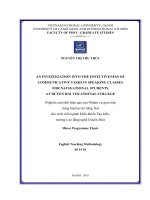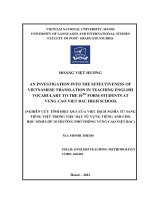An investigation of the effectiveness of virtual learning environment implementation in primary education docx
Bạn đang xem bản rút gọn của tài liệu. Xem và tải ngay bản đầy đủ của tài liệu tại đây (607.82 KB, 125 trang )
University of Leicester
MBA in Educational Management
Dissertation
An investigation of the effectiveness of
virtual learning environment
implementation in primary education
By
Miles Berry
2006
An investigation of the effectiveness of VLE implementation in primary education
Miles Berry 1
Abstract
Virtual Learning Environments (VLEs), understood here as online systems supporting
interactions between and amongst learners and teachers as well as access to resources
and activities, have long been held to provide a range of benefits in further and higher
education. For 2008, UK Government policy is far all pupils to have access to an online
learning space, for many provided through a learning platform such as a VLE. This
technology is presently little used in primary education and there are few objective case
studies evaluating the appropriateness and effectiveness of VLEs in this context. The
author has addressed potential impact of VLEs on school effectiveness through three
interrelated areas.
The contribution of VLEs to institutional knowledge management is considered.
Knowledge management has received little attention in education, and a small scale,
self-selecting sample online survey was used to identify the contribution of VLEs to this
area. Responses confirmed little use of knowledge management in schools, and mixed
use of VLE tools to codify teachers tacit knowledge; VLEs were however used to share
data, information and resources within the school, and supported a culture of
collaboration within, and in some cases beyond, the school, such a culture being
important for VLE effectiveness in this area. Schools rarely analysed VLE data to
support decision making.
The other two areas were addressed through a small scale action research project,
introducing the Moodle open source VLE to support the Year 5 and Year 6 mathematics
curriculum at the author’s school.
Evidence from a review of the relevant literature suggested that VLEs were particularly
supportive of social constructivist pedagogy, and the author used a variety of qualitative
and quantitative techniques, including the COLLES survey instrument, to identify the
An investigation of the effectiveness of VLE implementation in primary education
Miles Berry 2
extent to which introducing the VLE had promoted this approach to learning amongst
the pilot study cohorts. Within this particular context, there did seem evidence that the
VLE had promoted knowledge construction amongst pupils, an awareness of multiple
perspectives, stronger sense of ownership and voice, and a greater sense of learning as a
social experience. Pupils seemed to be more aware of their development as learners and
coped well with multiple modes of representation. They perceived that computer-based
activities were more relevant.
By keeping the curriculum and testing regimes unchanged from previous years, the
author was able to use a quasi-experimental method to compare progress during the
pilot study with that of previous cohorts, factoring out differences in prior attainment.
Evidence for improved attainment through the introduction of the VLE was inconclusive,
with only a small, statistically insignificant gain. Data mining techniques suggested that
pupils using the VLE in a more strategic manner received the greatest benefit.
The author concludes by making a number of recommendations to those seeking to
implement VLEs in other schools: including the need to choose a VLE suited to the
school’s vision and context, consideration of total cost of ownership, developing a
collaborative culture within and beyond the school, integration with other information
systems, and embedding the system within the school’s culture.
An investigation of the effectiveness of VLE implementation in primary education
Miles Berry 1
Contents
List of figures 3
List of abbreviations 5
Introduction 7
Literature Review 13
VLEs 13
Knowledge Management 19
Approaches to learning 24
Attainment 32
Methodology 35
Knowledge Management 35
The Pilot Study 37
Approaches to learning 41
Pupil Attainment 45
Analysis 47
Knowledge Management 47
Introduction to the pilot study 61
Approaches to learning 65
Pupil Attainment 79
Conclusion 85
Findings 85
Recommendations 90
An investigation of the effectiveness of VLE implementation in primary education
Miles Berry 2
Reference List 93
Appendix 1 Survey of VLE users in UK schools to investigate use for
knowledge management 109
Appendix 2 VLE Selection 119
Appendix 3 Modified COLLES Questions used for survey of pupil perceptions
and attitudes. 121
An investigation of the effectiveness of VLE implementation in primary education
Miles Berry 3
List of figures
Figure 1 Comparison between Schoolnet survey (EUN 2003) and this survey showing
phase of education 48
Figure 2 VLE use by type. 49
Figure 3 Reported use of VLE tools where present (this survey) 51
Figure 4 Reported use of VLE tools where present, Schoolnet survey (EUN 2003, Annex
III p19) 52
Figure 5 Opinion on VLE usage in relation to knowledge management 55
Figure 6 Opinions on the contribution of VLEs to learning 60
Figure 7 Screenshot showing some of the range of resources available 62
Figure 8 Screenshot showing interactive geometry activity 62
Figure 9 Screenshot showing immediate feedback from a homework quiz 62
Figure 10 Screenshot showing collaborative wiki activity 62
Figure 11 Screenshot showing discussion forum thread 63
Figure 12 Screenshot frame from a lesson recording 63
Figure 13 VLE usage 2004-2005 66
Figure 14 detail from the above, showing use over the Christmas Holiday, 2004-05 67
Figure 15 Variation in usage between pupils 68
Figure 16 Module usage per pupil per day 69
Figure 17 Survey of opinions of VLE usage (derived from Skinner 2005) 71
Figure 18 Box-Whisker plot showing results from simplified language COLLES at
beginning of pilot study 72
An investigation of the effectiveness of VLE implementation in primary education
Miles Berry 4
Figure 19 Box-Whisker plot showing results from simplified language COLLES at
conclusion of pilot study 73
Figure 20 SATs results in Mathematics, 1997-2006 80
Figure 21 Scatterplot of progress over Year 5, pilot cohort and two previous groups 81
Figure 22 Scatterplot of progress over Year 6, pilot cohort and two previous groups 82
Figure 23 Scatterplot of progress over academic year, pilot cohort and two previous
groups (combined plot of Year 5 and Year 6 classes) 83
An investigation of the effectiveness of VLE implementation in primary education
Miles Berry 5
List of abbreviations
Becta British Educational Communications and Technology Agency
CEM Curriculum, Evaluation and Management Centre
CIMT Centre for Innovation in Mathematics Teaching
CLE Constructivist Learning Environment
COLLES Constructivist on-line learning environment survey
CTC City technology college
DfES Department for Education and Skills
EUN European Schoolnet
FE Further education
Ferl Further Education Resources for Learning
HE Higher education
HMC Headmasters’ and Headmistresses’ Conference
ICT Information and communication technology
JISC Joint Information Systems Committee
LA Local Authority
LCMS Leaning Content Management Systems
MIS Management information system
MLE Managed learning environment
OECD Organisation for Economic Co-operation and Development
OSS Open source software
An investigation of the effectiveness of VLE implementation in primary education
Miles Berry 6
P Probability (used to indicate degree of statistical significance herein)
p2p Peer to peer
post Post-test assessment result
pre Pre-test assessment result
QCA Qualifications and Curriculum Authority
RBC Regional Broadband Consortium
SATIPS Society of Assistant Teachers in Preparatory Schools
SATs National Curriculum Tests (formerly standard assessment tasks/tests)
SIMS Schools Information Management System
SMS Short Message Service (ie mobile phone text message)
SMT Senior management team
UK United Kingdom
VLE Virtual learning environment
VoIP Voice over Internet Protocol
wiki Web page system in which pages are editable via a browser
Acknowledgements
The author wishes to record his thanks to Martin Dougiamas and the rest of the
worldwide Moodle community for the creation, development and continued support of the
open source VLE used for the pilot study.
He is also indebted to the governors, staff, parents and particularly pupils of his school
for their support of and participation in the pilot study.
An investigation of the effectiveness of VLE implementation in primary education
Miles Berry 7
Introduction
“Buying a VLE is one of the most important decisions for an institution, one
that has major implications for it, and should be seen as significant as buying
a major new building. The choice of VLE will be significant across all areas of
the institution and especially in the way in which teaching and learning are
undertaken.” (Minshull 2004, p20, cf Becta 2003 p40)
The decision to implement a virtual learning environment (VLE) in a primary aged
school presents advantages to, and raises issues for, school management, and is certainly
not one that should be taken lightly (Gill & Shaw 2004, qv Visscher & Wild 1997, p264,
Hargreaves 1999, p123, Visscher et al 2003, p364). VLEs appear to offer schools a
number of benefits, such as: anytime, anywhere access, improved motivation, access to
higher or novel learning styles, opportunities for independent learning, better
integration of information and communication technology (ICT) tools, and increased
parental engagement (Becta 2004a, qv DfES 2005c). There is therefore the potential for
“a significant impact on the process of teaching and leaning” (ibid); indeed Europe wide,
national agencies perceive VLEs as:
“Facilitators of changes in education and pedagogy towards more learner
centred approaches, enhancing interactivity in learning [and] helping
constructional knowledge building” (EUN 2003, p21, cf Land & Hannafin
2000, Pentland 2003).
Such an impact would suggest the need for consummate change management skills on
behalf of those leading such an implementation (DfES 2005c, Reyes 1997, qv Visscher &
Bloemen 2001, Davey et al 2001 p167). Moreover, management would be failing in its
responsibilities if the positive effect such benefits present were neither confirmed
empirically (qv Carswell et al 2000, p29, Oliver & Herrington 2003, p111) nor weighed
An investigation of the effectiveness of VLE implementation in primary education
Miles Berry 8
against the costs incurred with VLE implementation: financial, in terms of computer
hardware, software licensing, initial and ongoing staffing requirements and training
(Petre et al 1998, p116, Williams 2002, p270, Ash & Bacsich 2002, Becta 2003, p16, p30,
Maor 2003, p205, Minshull 2004, p7, cf Wild et al 2001, p117); potentially negative
effects on the morale of staff (Fung & Pun 1997); and issues of equality of access to the
curriculum (Williams 2002, p268, Becta 2003, p28).
There is, in what is still a relatively young field, some confusion over the use of terms
describing online learning systems (Gill & Shaw 2004, EUN 2003); the UK Further and
Higher Education (FE, HE) (JISC) definition seems to have become the most widely
accepted:
“A VLE is an electronic system that can provide online interactions of various
kinds that can take place between learners and tutors, including online
learning” (JISC, 2003a).
In their survey of VLE usage throughout European schools, European Schoolnet adopt a
broader definition:
“Any solutions that propose a coherent set of services with pedagogical aims,
supporting learning and teaching activities” (EUN 2003, Annex VI, p81).
Becta (2003, p8-9) helpfully provide a list of the different definitions used by commercial
developers. Within the UK schools sector, the term ‘learning platform’ has been adopted,
with an understanding that this includes, but is not limited to VLE type systems (DfES
2005c, Walker 2006). For the purpose of this study, the JISC definition will be adopted.
Although it is possible to trace the history of VLE style tools back to the earliest days of
educational computing (Inglis et al 2002 13-14, Winn 2002 p332-335, Ganesan et al 2002,
p94-95), widespread availability of the technology is quite recent and, it could be argued,
much of its present use may be motivated by technological advances rather than
An investigation of the effectiveness of VLE implementation in primary education
Miles Berry 9
educational needs (Esienstadt & Vincent 2000, preface p x, Darby 2002, p19-20, Konrad
2003, qv Taylor & Maor 2000, Porter 2003, Gill & Shaw 2004, p4, cf Ganesan et al 2002,
p105, Dougiamas & Taylor 2003). VLE usage at present is concentrated in the higher
and further education (HE, FE) communities, where it has been taken up with some
enthusiasm (Inglis et al 2002): for example half of English FE colleges already had a
VLE in place by 2001 (Becta 2003). However, “the school sector VLE market is still very
immature” (Gill & Shaw 2004, qv Becta 2003 p16), although there is a growing interest
in the use of VLEs particularly within secondary education, and the DfES are committed
to providing all pupils with access to a personal online learning space by 2008 (DfES
2005b), in most cases to be provided via an institutional learning platform.
Given Becta’s (2003) former position that “a fully integrated VLE [may] not be
appropriate for a primary school at this stage in VLE development” (p35), and Gill and
Shaw’s (2004) perception that primary schools rely “on external inputs to develop their
understanding, vision and resultant use of any provided solution” (p3), it is unsurprising
that at present there is little evidence of more than isolated use within primary
education: in 2003, Becta failed to identify a single UK primary school using a VLE as
defined above, (Becta 2003, p34, cf Visscher et al 1999), although a small number of case
studies have emerged more recently (DfES 2005c).
A mere 24 UK schools responded to Schoolnet’s 2002 survey (EUN 2003, p7), and only
10% of all responses were in the elementary sector. In 2003, only 36 independent schools
(6% of respondents) reported that curriculum on-line initiatives had any impact, with no
others indicating that such initiatives, other than virtual language labs, were planned
(ISC 2004). However, increasing numbers of schools are exploring this technology, and it
seems likely that some of this work will be formally documented. Nevertheless, given the
An investigation of the effectiveness of VLE implementation in primary education
Miles Berry 10
longer history of VLE usage in HE and FE, almost all academic work on VLE usage has
focussed on these sectors.
Thus, for a school about to embark on VLE implementation, there seems much promise
of what VLEs may offer and some worries as to the downside of that implementation, but
very little evidence to support management in their decision to proceed with such an
implementation (Gill & Shaw 2004, qv Cohen et al 2000, p394-5, cf Ganesan et al 2002,
p93). This study seeks to address this want of evidence by investigating the extent to
which VLE implementation in a primary aged school can be shown to be effective.
In their analysis of the costs of networked learning, Ash & Bacsich (2002, p29) state
“there is a genuine need to develop a methodology to measure effectiveness”, (qv Konrad
2003). In this study, effectiveness is considered in three interrelated areas: knowledge
management, pupils’ approach to learning, and academic performance, as described in
the review of literature below (qv EUN 2003, p35, Becta 2003 p32). The areas are
interrelated: more effective knowledge management, including an emphasis on the
shared construction of knowledge, would affect the approach to learning in a school,
which might in turn impact on academic performance, such academic performance data
being fed back into a school’s knowledge management procedures. These areas translate
into three specific research questions:
Firstly, to what extend does a VLE represent an effective tool for knowledge
management within a school, including its use for core management tasks such as
planning, accountability, resource management and performance tracking?
Secondly, can VLE implementation be shown to have a positive impact on pupils’
approach to, attitudes about, and perception of their work?
Thirdly, does the implementation of a VLE have any significant impact on pupils’
measurable academic performance?
An investigation of the effectiveness of VLE implementation in primary education
Miles Berry 11
The author’s own school is a small (c. 150 on roll), non-selective independent preparatory
school for girls, situated in an affluent part of the South East. An informal survey of
parents indicates that almost all have personal computers and Internet connections at
home (compared to 49% of UK households with Internet access, (National Statistics
2004)), which are available for their daughters to use: issues of access to online resources
and the ‘digital divide’ are therefore less relevant than they may be elsewhere.
Furthermore, the school has a high level of ICT provision with one computer per 3.5
pupils, compared 7.5 pupils in English primary schools (DfES 2004a), and the school’s
ICT provision was commented on favourably in its most recent inspection report. Such
characteristics might facilitate the introduction of a VLE, but also make the difficulties
in extrapolating conclusions from a small-scale study more acute.
The author, as deputy head of the school, has become interested in exploring knowledge
management within the school’s context and this has lead to the school’s ongoing
investigation of school management information systems (MISs) and VLEs. Prior to
embarking on the wide ranging change that VLE implementation throughout the school
would necessitate (Minshull 2004, p28, Gill & Shaw 2004), it seemed wise for the school
to conduct a smaller scale pilot study: to gain expertise in the issues involved in VLE use
(allowing the author to take on an ‘e-learning champion’ type role, as has proven
effective in FE implementations (Ferl 2006)), to obtain evidence of VLE effectiveness (qv
CEM 2004), and to inform subsequent cost-benefit analysis (Davey et al 2001, p169). The
author therefore conducted a small scale and low cost pilot study of VLE usage within
his own teaching of mathematics to Year 5 and 6 classes; pilot implementation being a
well established technique in ICT innovation (Darby 2002 p23, EUN 2003, Becta 2003,
Konrad 2003, Becta 2004b, Gill & Shaw 2004 appendix, Minshull, 2004). This pilot study
An investigation of the effectiveness of VLE implementation in primary education
Miles Berry 12
provided the evidence base on which the second and third of the research questions were
addressed, as described below.
It was hoped that the pilot would itself be of benefit to those pupils participating in it,
but also that the insights gained would enable subsequent full implementation to be
accomplished more successfully, with consequent benefits to the school as a whole.
Concluding remarks therefore seek to address a fourth research question: what can
school management do to ensure the maximum effectiveness of VLE implementation?
Since, after all, the “integration of new technology into classroom practice is essentially a
problem for management” (Newton, 2003, qv Minshull 2004, p5).
An investigation of the effectiveness of VLE implementation in primary education
Miles Berry 13
Literature Review
Before considering literature relevant to the specific research questions above, it seems
appropriate to provide a perspective on literature pertaining to VLEs in general.
VLEs
VLEs are the focus of a rapidly expanding field of academic research, as the number of
dedicated journal titles and conferences attest. The field is now sufficiently mature that
overviews of the literature have begun to appear, such as those by Winn (2002), Williams
(2002), Konrad (2003) and Becta (2003 and 2004a). However, as use within UK schools is
still rather limited, little of the literature deals with this area specifically. Those
exploring this field at present must use: studies from within HE and FE (qv Dillon 1998,
p36), where factors such as more flexible patterns of attendance, greater institutional
control over curriculum and assessment, typically lower staff teaching commitments,
and greater familiarity with flexible learning can apply; software developers case
studies, with a potential lack of objectivity and difficulties in generalizing claims made;
or studies from overseas, although even in this case there is little work based in schools,
and even less in primary schools (Becta 2003). Furthermore, Becta view much of what
evidence there is for the benefits of VLEs as anecdotal or inconclusive (ibid, p11, 40 cf
Visscher 2001, p10).
One tension running through much of the literature seems to be between VLEs as a
better mechanism for traditional curriculum delivery on the one hand and as facilitators
of wide reaching pedagogical change on the other:
“Networked learning can be seen as a progressive site of radical pedagogical
experiments, emphasizing the anti-hierarchical structure of the web and the
way in which social status differences become invisible in cyberspace, or it
can be seen as an instrumentally superior form of knowledge transmission.”
An investigation of the effectiveness of VLE implementation in primary education
Miles Berry 14
(Fox 2002, p80, qv Esienstadt & Vincent 2000, Nolan & Lambert 2001, p82,
Becta 2003, p38, EUN 2003, p4, Haughey 2003, Tatnall & Pitman 2003,
Barbera 2004, p16).
Attention to both academic performance and approaches to learning in this study
maintains this tension. Mäkelä (1997) seems to hold both views, in that he believes
information products must
“guide readers through an information space, controlling their exploration
along the lines of pre-defined structures” (p28),
yet acknowledges
“students’ responsibility for their own learning and their active role in
seeking and using this information” (p29).
Winn (2002) sees this distinction as evolutionary, in that today’s VLEs have grown out of
carefully designed instruction and interactive simulations. From a psychological
standpoint, earlier computer assisted learning sat well with Piagetian behaviourist
perspectives, whereas the utilization of networked communication tools place VLEs more
comfortably within a Vygotskian view of the social nature of learning (ibid, Dillon 1998,
p34). The emphasis on a social constructivist paradigm common to much work on VLEs
(see eg Jonassen & Land 2000, Konrad 2003, Oliver & Herrington 2003) is further
evidence in support of this view. The more traditional emphasis is perhaps clearer
within Learning Content Management Systems (LCMS), which provide the “ability to
store, assemble and deliver personalised learning content in the form of learning objects”
(EUN 2003, p10), and this understanding might perhaps underpin the attention given to
personalised content and adaptive learning design apparent in some of Becta’s (2006a)
functional requirements for learning platforms.
An investigation of the effectiveness of VLE implementation in primary education
Miles Berry 15
Despite this tension, there seems broad agreement on what a VLE actually is. Gill and
Shaw (2004) expand on the rather broad JISC definition to provide a more useful
description of a VLE, perhaps with a just perceptible behaviourist slant:
“A system, in which learners, organised into groups and following online
programmes of study, access structured and managed online content,
resources and assessments through a web browser. In these systems, teachers
have the ability to create and manage resources, collaborate with colleagues
and manage the collaboration and communication with and between
students. The system tracks usage by learners, progress of learners through
courses and automatically marks and records the results of simple tests.” (p1,
qv Minshull 2004)
Becta (2006a) give a more (perhaps overly) detailed functional specification from an
institutional or system wide perspective, grouping requirements into four broad
categories of content management, curriculum mapping and planning, learner
engagement and administration, and tools and services, although previously (2003, p6)
they had simply listed core components as: a bulletin board, course outline, email,
conferencing tools, home pages, metadata, assignments, assessments, chat, multimedia
resources, file upload, and calendar. Williams (2002, p265) suggests elements that might
feature on course websites, adding glossaries to the above list. Schoolnet (EUN 2003, p8)
look to the future, and see the evolution of VLEs as integrating the above components
with tools for knowledge building, linkage with administrative information and
diagnostic tools. Despite this broad agreement, VLE usage in an institution may vary
widely, and it is unlikely that all schools will realize the full potential (DfES 2006, EUN
2003 p26, qv Jonassen 1999, p219).
An investigation of the effectiveness of VLE implementation in primary education
Miles Berry 16
Several authors (eg Becta 2003, Minshull 2004, DfES 2005c) provide lists of the potential
advantages for institutions and for students that VLE adoption offers. Most of these fit
readily within the areas of more effective knowledge management and improved
approaches to learning discussed in more detail below, and some can be seen as having
the potential to raise pupil attainment, such as the ability to catch up on missed classes
(Minshull 2004, p26, DfES 2005c, p11), instant feedback on assessment (Becta 2003,
p18) and cross institutional working (DfES 2005c, p10).
One key advantage is the opportunity to provide access to the institution’s curriculum
from outside its boundaries (DfES 2005c, p8-11, Becta 2003, p14, 15, 19, 28, qv Fung &
Pun 1997, p18, Smith & Wild 2001, p139, Ganesan et al 2002): either for pupils
completing homework; those not able to attend school; those attending other institutions
(as Thomas Telford CTC has done, see www.ttsonline.net/general/projects
/ttscourses.html); or, particularly in the case of HE, distance learning students. This can
be seen as an aspect of knowledge management, as the institutions involved have
identified a new way of exploiting their shared intellectual capital (qv Sallis & Jones
2002, p90-92, Porter 2003, p381). Furthermore, staff access to the VLE from home
provides opportunities for more flexible working arrangements (Haughey 2003)
The European Schoolnet survey (EUN 2003) provides some empirical evidence on actual
usage of VLEs in European schools. However, as VLE usage is a fast developing field
and this survey relied on volunteer responses, its conclusions should not be regarded as
entirely reliable or representative (Cohen 2000, p102), nevertheless some points seem of
particular interest for this study. The survey found that two-thirds of respondents were
using VLEs with their own classes, perhaps as early adopters in pilot studies, but a
quarter of these teachers were also using VLEs to support teaching outside their own
school, often in the form of international school collaboration. Teachers seemed
An investigation of the effectiveness of VLE implementation in primary education
Miles Berry 17
comfortable using the VLE in a conventional classroom setting but were less willing to
explore its full potential. Schoolnet suggested that this might be due to the HE focused
development of the then generation of VLEs (EUN 2003, p35). For mathematics
teaching, the curriculum area in the pilot study, VLEs were used regularly by 31% of
respondents and at least “sometimes” by 78% (ibid, p18).
Despite worries about ‘the digital divide’ (Smith & Wild 2001, p159, Sallis & Jones 2002,
Valentine et al 2005) and concerns over equality of access to an online curriculum (Becta
2003, p28, Williams 2002 p268), VLEs can enable greater access to the curriculum,
through specific technological innovation (Vincent & Whalley 1998, DfES 2005c qv
Konrad 2003), but also simply as computer mediated communication can make it easier
for shy or quiet students to join in (Rimmershaw 1999, p199, Williams 2002, p266).
VLEs are commonly used to provide a meta-environment, integrating a rich mix of
online resources (Sumner & Taylor 1998, Jonassen 1999, p225, qv Montieth & Smith
2001). This is a common way for online courses to be created (Minshull 2004, p25) and
gives the teacher the role of ‘knowledge broker’ (Fung & Pun 1997, Davenport & Prusak
2000, p29-30), which is important due to the enormous amount and varying quality of
information available to the learner (Kayama & Okamoto 2002, p250), and because “The
process of seeking information may distract learners from their primary goal of problem
solving” (Jonassen 1999, p228, qv Kirschner et al 2006).
There is a need to “ensure that students learning experiences are improved rather than
simply replaced or confused” (Williams 2002, p264), rather than merely publishing
overhead slides, text book extracts and exercises online (Esienstadt and Vincent 2000,
Darby 2002, Oliver & Herrington 2003): Petre et al (1998) argue that success is
dependent on cultural change for both student and tutor, whilst acknowledging that
good teaching is indispensable (qv Mäkelä 1997). However, Spector warns that:
An investigation of the effectiveness of VLE implementation in primary education
Miles Berry 18
“The role of teaching in technology intensive settings is more difficult and
more crucial than ever before. Only a rare few master the skills required to
effectively integrate technology into learning and instruction, and teachers
themselves admit this.” (2002, p xiv).
The implied redesign of courses (Oliver & Herrington 2003) can “be a positive
experience, providing a chance to review the curriculum and reassess learning outcomes”
(Williams 2002, p264), with clear potential for organizational learning. From a
knowledge management perspective, there are clear benefits to digitising course content
which previously might have existed “only in the heads of tutors” (op cit), or in their
private planning. Moreover, digitisation enables learners to become “active in seeking
information and constructing their own learning experience, rather than being ‘passive
receptors of knowledge’” (op cit).
However, as Minshull (2004) reports, there is
“Considerable dissatisfaction within some areas of the school educational
community in what is currently being offered as a VLE solution.” (p15, qv Gill
& Shaw 2004, p4, EUN 2003, p34, cf Fulmer & Frank 1997, p128, Leidner
2003, p498, Porter 2003 p 380, Lobry de Bruyn 2004, p67)
It is possible that the dissatisfaction is due to the lack of involvement of teachers in the
development of the commercial products used, which may have resulted in a poor fit to
schools’ pedagogic requirements:
“Most of the current generation of VLEs are not designed to support learning
changes but to deliver distance-learning courses to university students” (EUN
2003, p35, cf Fung & Visscher 2001, p82, Tatnall & Davey 2001, p63, Wild et
al 2001, p118)
An investigation of the effectiveness of VLE implementation in primary education
Miles Berry 19
With this in view, it seems odd that Becta’s (2006a) list of functional requirements has
been drafted with relatively little consultation with schools, teachers or learners.
Knowledge Management
“In the information society, knowledge forms the foundation for education
and culture” (Smith & Wild 2001, p152)
The field of knowledge management is of great importance in industry and business
generally, in part because technological economies are increasingly knowledge based
(Sallis & Jones 2002 p xii, qv OECD 2000 p67), but also through a growing realization
that intellectual capital is the key driver in organizational success (Osorio et al 2001,
p41-42, Sallis & Jones 2002, p1). There is also a realization that an organization’s people
are the locus of much of its knowledge, and the field has matured alongside advances in
technological potential.
In education, it has received little attention (OECD 2000, p70, Sallis & Jones 2002 p xiv,
Thorn 2003, p22, Kirkup et al 2005), although there are notable exception such as
Hargreaves (1998, 1999), OECD (2000) and Sallis & Jones (2002). Whilst it is not
unusual for techniques of management in education to lag behind those in the wider
world (Smith & Wild 2001, p140, cf OECD 2000, p70), this seems surprising in this case,
as education is surely all about transmitting and/or cultivating knowledge (OECD 2000,
p70, Sallis & Jones 2002 p xiv). The following review of relevant literature focuses on
those aspects of knowledge management in schools that might be best facilitated through
use of a VLE, and thus also draws on research into school management information
systems.
Quintas (2002) observes that
An investigation of the effectiveness of VLE implementation in primary education
Miles Berry 20
“For the majority of firms in the west, the priorities are the ‘capture’ of
employees’ knowledge, exploitation of existing knowledge resources or assets,
and improved access to expertise.” (p9)
One key difficulty for those seeking to do this in education is the high proportion of a
teacher’s knowledge that is tacit rather than explicit. (Fulmer & Frank 1997, p126,
Hargreaves 1999, p138, OECD 2000, p71), and thus the challenge seems to be to find a
way to externalise or codify the pedagogic insights which are “locked in the heads of
individual teachers and protected by the privacy of their classrooms” (Hargreaves, 1999,
p124, qv Goodyear 2002, p64). Whilst some of this knowledge will undoubtedly remain
tacit, VLEs have the potential to make much that pertains to this knowledge, such as
lesson planning (Becta 2003, p35, Konrad 2003, Haughey 2003, p67), online resources
(Becta 2003, p29, EUN 2003), assessment data (Haughey 2003), and even pupil-teacher
discussions (qv Lobry de Bruyn 2004) explicit and capable of codification, and thus
readily accessible storage. Moreover, such a knowledge mapping (Davenport & Prusak
2000, p72-80) naturally codifies the teachers’ knowledge into the categories which are
meaningful for others’ professional practice (Hargreaves 1999, p125), and, through such
a digital representation, it becomes easier
“To talk concretely about what we know; to diagnose weaknesses in what we
know; [and] to improve ways of knowing.” (Esienstadt & Vincent, 1998, p15)
Through computer networks (Osorio et al 2001, p36, Pentland 2003, p529), these aspects
of teachers’ working knowledge can be readily shared throughout the organization.
Sharing information, which is not uncommon in primary schools (Nolan & Lambert
2001, p72), seems key to organizational success in a knowledge based society (Reyes
1997, p76, qv Pentland 2003, p547) and makes possible the shared decision making on
An investigation of the effectiveness of VLE implementation in primary education
Miles Berry 21
which a school’s growth as a learning organization depends (Nolan & Lambert 2001, p83,
qv Reyes 1997, p74, Brown & Duguid 2002, p25, Quintas 2002, p10).
This sharing can extend beyond the organization’s boundaries and, while the Schoolnet
survey (EUN 2003) suggested that VLE usage was perceived principally as a tool for
teachers to organize their own work, it also indicated a high level of usage of
communication tools for professional collaboration (qv OECD 2000, p77, cf p98).
Furthermore, VLEs allow teachers to create content and share it with educators around
the world (Becta 2003, p37, qv Berry & Partridge 2006), to work collaboratively on
instructional design (Ganesan et al 2002), and, by drawing together resources from
outside an organization, make it easier for schools to absorb knowledge created
elsewhere (Quintas 2002, p7). Transfer and reusability of content is therefore important
if VLEs are to become effective knowledge management tools (Becta 2003, EUN 2003,
DfES 2005a). Such reusability depends upon the development of interoperability
standards, which is now a priority for national agencies throughout Europe (ibid, DfES
2004b): the Schoolnet paper provides an overview of some of the relevant standards
(EUN 2003, p30) and Becta (2006b) have specified a number of these for English schools,
although Konrad (2003) warns that specification may reflect “market power rather than
educational needs”.
Making teacher’s working knowledge readily accessible in this way and then allowing
others to adapt it to their own context facilitates true knowledge transfer (Hargreaves,
1999 p131-2, cf OECD 2000, p75), and provides a mechanism for validating knowledge
by turning it “into practice which demonstrably and repeatedly works” (Hargreaves
1999, p128).
The wealth of data and information which a fully populated VLE would contain would
allow new knowledge, in the form of trends, patterns and exceptions in student data, to
An investigation of the effectiveness of VLE implementation in primary education
Miles Berry 22
be isolated through techniques such as data mining (Wild et al 2001, cf Brown & Duguid
2002, p27); although it is important to avoid information overload (Visscher &
Branderhorst 2001, p148, p152). Such techniques could facilitate better-informed
decision making for management (ibid), customer relationship management, and pupil
support (Visscher & Wild 1997, p271, Kirkup et al 2005).
Such claims were made for school management information systems, which have long
had a place within the information infrastructure of schools, but have had relatively
little impact on actual classroom practice (Visscher & Wild 1997, Fulmer & Frank 1997).
This is perhaps because they do not capture the knowledge or information that teachers
and manages actually use in their daily lives, (Quintas 2002, p8, qv Witziers 1999, p113,
Visscher 2001, p9), or because they were designed to meet accountability demands
(Nolan & Lambert 2001, p79, Thorn 2003). A VLE, however, is designed to manage the
knowledge that is at the core of the school’s activity, ie teaching and learning. This is an
important distinction, as
“Information systems can affect the critical process of knowledge construction
and organization by changing the epistemic criteria used in knowledge
construction and by changing the content of the material that emerges from
the creation process.” (Pentland 2003, p534, qv p526)
A VLE is also more accommodating “of the inherent complexity, sophistication and
subtlety of professional life and work in educational institutions” (Nolan & Lambert
2001, p83) and facilitates analysis of qualitative data (ibid, p79, p83).
Interoperability, and perhaps ultimately integration (Smith & Wild 2001), with MIS
software would seem to be important in ensuring the greatest benefit of VLEs from a
knowledge management perspective (Visscher 2001, p15) and greater relevance of MIS
to classroom practice. The term managed learning environment (MLE) is used for


